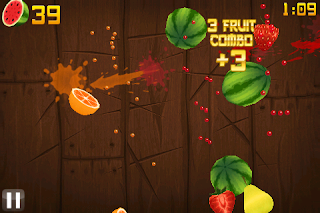This past weekend, The International Video Game Hall of Fame and Museum in Ottumwa, Iowa (I only wish I was making that up) was formally launched with the announcement of its "Inaugural Class" Inductees, which can be found
here. Individual games, designers, and gamers were all inducted, but for many people, two names stood out. Donkey Kong champions Steve Wiebe and Billy Mitchell have become celebrities beyond the narrow realm of competitive video games, thanks to Seth Gordon's sorta-documentary,
The King of Kong: A Fistful of Quarters. The film continues to receive high praise, despite the fact that it seriously distorts the events it claims to document.
As part of the weekend festivities, Mitchell regained the Donkey Kong crown from current champion Hank Chien, scoring 1,062,000. Mitchell also regained the Donkey Kong Jr. crown.
Congratulations to everyone inducted, and I wish the Museum much success if it ever gets built.
In the meantime, I thought I'd share what I wrote about
The King of Kong when it first came out. It's an important example of why you shouldn't accept documentaries (or even news) at face value.
The King of Kong
The passionate core of any hobby—be it model trails, sci-fi, or coin-op gaming—is usually comprised of quirky misfits and fringe personalities. People who dedicate all their spare time and disposable income to a single pursuit are rarely the most well-adjusted, mainstream members of society, but they can be the most interesting. Ten years ago, director Roger Nygard’s film Trekkies showed us some of the oddball personalities forming the hard core of Star Trek fandom. Now, first-time feature director Seth Gordon’s The King of Kong does something similar for the classic or coin-op gaming community.
Gordon’s film is the latest in series of classic gaming documentaries, including High Score (chronicling Bill Carlton’s quest to break the Missile Command record) and Chasing Ghosts: Beyond the Arcade (which catches up with top score-holders featured in a seminal 1982 Life Magazine spread). King of Kong enters this world through one very specific rivalry for one coveted world record.
Top score in Donkey Kong is no easy feat. Shigeru Miyamoto’s first masterpiece can be ridiculously difficult to beat, thanks to its tricky timing and the high number of obstacles (barrels, fireballs, springs). The film casts Billy Mitchell as the record-holding goliath in the contest, depicting him as an arrogant jerk willing to do anything to hold onto his record. Mitchell is the top celebrity of the coin-op gaming circuit: a charismatic, mullet-haired entrepreneur who functions as the hobby’s unofficial mascot and spokesman. Though he held numerous records throughout the 80s and 90s, by the time the film was made all but Donkey Kong had fallen, leaving him as more of a figurehead. King of Kong depicts him as little more than a Machiavellian schemer who’s afraid to defend his own record in public.
Pitted against him is the quiet, likable family man Steve Wiebe, a talented obsessive-compulsive high-school science teacher who always seems to fumble just when he seems on the brink of success. Wiebe looks at the Donkey Kong record, says “I can beat that,” wheels a DK machine into his garage, and begins to work on creating a new World Record in Donkey Kong. After he succeeds, he sends the tape of his achievement to Twin Galaxies, the semi-official leaderboard and sanctioning agency for competitive gaming, and waits for his record to be acknowledged.
It’s not to be. As Gordon and his cameras document the process, we get an inside look at the strange personalities that orbit around Mitchell and the coin-op gaming scene. Twin Cities founder Walter Day, judge Robert Mruczek, Mitchell pals Brian Kuh and Steve Sanders, Doris Self (a 79-year-old grandma who has the top Qbert score), and Wiebe’s shady benefactor, a bizarre cartoon of a man named Roy “Mr. Awesome” Shildt, all figure into the story as Twin Cities rejects Wiebe’s high score, and insists he reproduce it in a live venue. At the moment of Steve’s victory, Doris Self delivers a dodgy videotape appearing to show a new record breaking high score by Mitchell.
There is no question that all of this makes for an entertaining film full of interesting characters with mixed motives, many of them appearing to conspire against a likable guy to keep him from getting his due. As a documentary, however, the film is troubling and fundamentally dishonest. Through clever editing and selective omissions, it paints Mitchell as a puffed up has-been who is afraid to play in public, a coward who avoids meeting his competitor, and an obnoxious braggart who uses his influence to steal the record back from an underdog.
In fact, Wiebe and Mitchell had already met and competed in public in 2004, before the events of the documentary: a point never mentioned in the film. More serious is the fact that Mitchell didn’t even hold the record Wiebe was competing against. Mitchell’s original score was broken by Tim Sczerby in 2001. Thus, the entire premise of King of Kong simply collapses, and it becomes clear that Seth Gordon merely wanted the colorful contrast of braggart Mitchell (and even his most obnoxious quotes are little more than the kind of macho smack talk gamers always use against each other, and far from the worst I’ve heard) and the nice-guy Wiebe.
King of Kong is the work of a new generation of documentarians influenced by the fundamentally dishonest work of Michael Moore, who edits his footage to distort the truth and create events that never happened. They seem to be less interested in the role of the documentary in conveying truth than in polemics and over-the-top reality-TV-style dramatics. King of Kong makes for good entertainment and offers an entertaining snapshot of the world of coin-op competition and fandom, but it’s also dishonest and manipulative.












